Meta-Analysis of the Effects of Plyometric Training on Lower Limb Explosive Strength in Adolescent Athletes
Abstract
1. Introduction
2. Information and Research Methods
2.1. Search Strategy
2.2. Study Selection
2.3. Data Extraction
2.4. Assessment of Risk of Bias
2.5. Statistical Analysis
3. Results
3.1. Study Characteristics
3.2. Risk of Bias in the Included Articles
3.3. Meta-Analysis Results
3.3.1. Jumping Performance
3.3.2. Speed Performance
3.4. Reporting Bias
4. Discussion
4.1. Jumping Performance
4.2. Sprint Performance
5. Limitations
6. Conclusions
Author Contributions
Funding
Institutional Review Board Statement
Informed Consent Statement
Data Availability Statement
Conflicts of Interest
Abbreviations
| SSC | Stretch-shortening cycle |
| CMJ | Countermovement jump |
| SJ | Squat jump |
| SLJ | Standing long jump |
| 10 m | 10-m sprint |
| 20 m | 20-m sprint |
| RCTs | Randomized controlled trial studies |
| PRISMA | Preferred Reporting Items for Systematic Reviews and Meta-Analyses |
| WMD | weighted mean difference |
| PT | Plyometric training |
| CON | Control group |
| M | Man |
| W | Woman |
References
- Wilk, K.E.; Voight, M.L.; Keirns, M.A.; Gambetta, V.; Andrews, J.R.; Dillman, C.J. Stretch-shortening drills for the upper extremities—Theory and clinical-application. J. Orthop. Sport. Phys. Ther. 1993, 17, 225–239. [Google Scholar] [CrossRef] [PubMed]
- Svantesson, U.; Grimby, G.; Thomee, R. Potentiation of concentric plantar flexion torque following eccentric and isometric muscle actions. Acta Physiol. Scand. 1994, 152, 287–293. [Google Scholar] [CrossRef] [PubMed]
- Hewett, T.E.; Stroupe, A.L.; Nance, T.A.; Noyes, F.R. Plyometric training in female athletes—Decreased impact forces and increased hamstring torques. Am. J. Sport. Med. 1996, 24, 765–773. [Google Scholar] [CrossRef] [PubMed]
- Hill, A.V. First and Last Experiments in Muscle Mechanics; Cambridge University Press: Cambridge, UK, 1970. [Google Scholar]
- Cavagna, G.A.; Saibene, F.P.; Margaria, R. Effect of Negative Work on the Amount of Positive Work Performed by an Isolated Muscle. J. Appl. Physiol. 1965, 20, 157–158. [Google Scholar] [CrossRef] [PubMed]
- Asmussen, E.; Bondepet, F. Storage of elastic energy in skeletal-muscles in man. Acta Physiol. Scand. 1974, 91, 385–392. [Google Scholar] [CrossRef]
- Bosco, C.; Komi, P.V. Potentiation of the mechanical-behavior of the human skeletal-muscle through prestretching. Acta Physiol. Scand. 1979, 106, 467–472. [Google Scholar] [CrossRef]
- Bosco, C.; Komi, P.V.; Ito, A. Prestretch potentiation of human skeletal muscle during ballistic movement. Acta Physiol. Scand. 1981, 111, 135–140. [Google Scholar] [CrossRef]
- Bosco, C.; Ito, A.; Komi, P.V.; Luhtanen, P.; Rahkila, P.; Rusko, H.; Viitasalo, J.T. Neuromuscular function and mechanical efficiency of human leg extensor muscles during jumping exercises. Acta Physiol. Scand. 1982, 114, 543–550. [Google Scholar] [CrossRef]
- Haff, G.G.; Triplett, N.T. Essentials of Strength Training and Conditioning, 4th ed.; Human Kinetics: Champaign, IL, USA, 2015. [Google Scholar]
- Kraemer, W.J.; Mazzetti, S.A.; Nindl, B.C.; Gotshalk, L.A.; Volek, J.S.; Bush, J.A.; Marx, J.O.; Dohi, K.E.I.; Gómez, A.L.; Miles, M.; et al. Exercise, Effect of resistance training on women’s strength/power and occupational performances. Med. Sci. Sport. Exerc. 2001, 33, 1011–1025. [Google Scholar] [CrossRef]
- Bassey, E.J.; Fiatarone, M.A.; O’neill, E.F.; Kelly, M.; Evans, W.J.; Lipsitz, L.A. Leg extensor power and functional performance in very old men and women. Clin. Sci. 1992, 82, 321–327. [Google Scholar] [CrossRef]
- Jensen, R.L. Ground reaction forces of variations of plyometric exercises on hard surfaces, padded surfaces and water. In Proceedings of the XXVIII Conference of the International Society of Biomechanics in Sports, Marquette, MI, USA, 25–29 July 2021. [Google Scholar]
- Wahba, A.M.; El Nahass, M.M. Effect of plyometric exercise in water and grass on indicators of protein catabolism, muscle damage and muscle inflammation. Int. Sci. J. Phys. Educ. Sport Sci. 2017, 5, 38–44. [Google Scholar] [CrossRef]
- Rajakamal, S. Effectiveness of Plyometrics Training in Sand Versus Ground in Basketball Players: A Comparative study. Ph.D. Thesis, Mohamed Sathak AJ College of Physiotherapy, Chennai, India, 2018. [Google Scholar]
- Karver, A.A. Sand Jump Training versus Ground Jump Training for Volleyball Players. Master’s Thesis, California State University, Sacramento, CA, USA, 2012. [Google Scholar]
- Faigenbaum, A.D.; McFarland, J.E.; Keiper, F.B.; Tevlin, W.; Ratamess, N.A.; Kang, J.; Hoffman, J.R. Medicine, Effects of a short-term plyometric and resistance training program on fitness performance in boys age 12 to 15 years. J. Sport. Sci. Med. 2007, 6, 519. [Google Scholar]
- Fouré, A.; Nordez, A.; Cornu, C.J. Effects of plyometric training on passive stiffness of gastrocnemii muscles and Achilles tendon. Eur. J. Appl. Physiol. 2012, 112, 2849–2857. [Google Scholar] [CrossRef] [PubMed]
- Häkkinen, K. Neuromuscular fatigue in males and females during strenuous heavy resistance loading. Electromyogr. Clin. Neurophysiol. 1994, 34, 205–214. [Google Scholar] [PubMed]
- Stojanovic, E.; Ristic, V.; McMaster, D.T.; Milanovic, Z. Effect of Plyometric Training on Vertical Jump Performance in Female Athletes: A Systematic Review and Meta-Analysis. Sport. Med. 2017, 47, 975–986. [Google Scholar] [CrossRef]
- Oxfeldt, M.; Overgaard, K.; Hvid, L.G.; Dalgas, U. Effects of plyometric training on jumping, sprint performance, and lower body muscle strength in healthy adults: A systematic review and meta-analyses. Scand. J. Med. Sci. Sport. 2019, 29, 1453–1465. [Google Scholar] [CrossRef]
- De Villarreal, E.S.S.; Requena, B.; Newton, R.U. Does plyometric training improve strength performance? A meta-analysis. J. Sci. Med. Sport. 2010, 13, 513–522. [Google Scholar] [CrossRef]
- Kaeding, C.C.; Whitehead, R. Musculoskeletal injuries in adolescents. Prim. Care 1998, 25, 211–223. [Google Scholar] [CrossRef]
- Lipp, E.J. Athletic physeal injury in children and adolescents. Orthop. Nurs. 1998, 17, 17. [Google Scholar]
- Allerheiligen, B.; Rogers, R.J.S. Conditioning, Plyometrics program design. Strength Cond. 1995, 17, 26. [Google Scholar] [CrossRef]
- Holcomb, W.R.; Kleiner, D.M.; Chu, D.A. Plyometrics: Considerations for safe and effective training. Strength Cond. J. 1998, 20, 36–41. [Google Scholar] [CrossRef]
- Chu, D.A.; Faigenbaum, A.D.; Falkel, J.E. Progressive Plyometrics for Kids; Healthy Learning: Monterey, CA, USA, 2006. [Google Scholar]
- World Health Organization, Global Accelerated Action for The health of Adolescents ( AA-HA!): Guidance to Support Country Implementation; World Health Organization: Geneva, Switzerland, 2017.
- Higgins, J.P.; Thompson, S.G.; Deeks, J.J.; Altman, D.G. Measuring inconsistency in meta-analyses. BMJ 2003, 327, 557–560. [Google Scholar] [CrossRef]
- Attene, G.; Iuliano, E.; Di Cagno, A.; Calcagno, G.; Moalla, W.; Aquino, G.; Padulo, J. Improving neuromuscular performance in young basketball players: Plyometric vs. technique training. J. Sport. Med. Phys. Fit. 2015, 55, 1–8. [Google Scholar]
- Chelly, M.S.; Hermassi, S.; Shephard, R.J. Effects of in-season short-term plyometric training program on sprint and jump performance of young male track athletes. J. Strength Cond. Res. 2015, 29, 2128–2136. [Google Scholar] [CrossRef] [PubMed]
- Fathi, A.; Hammami, R.; Moran, J.; Borji, R.; Sahli, S.; Rebai, H. Effect of a 16-Week Combined Strength and Plyometric Training Program Followed by a Detraining Period on Athletic Performance in Pubertal Volleyball Players. J Strength Cond Res 2019, 33, 2117–2127. [Google Scholar] [CrossRef] [PubMed]
- Fischetti, F.; Vilardi, A.; Cataldi, S.; Greco, G. Effects of plyometric training program on speed and explosive strength of lower limbs in young athletes. J. Phys. Educ. Sport 2018, 18, 2476–2482. [Google Scholar]
- Hammami, M.; Gaamouri, N.; Shephard, R.J.; Chelly, M.S. Effects of contrast strength vs. plyometric training on lower-limb explosive performance, ability to change direction and neuromuscular adaptation in soccer players. J. Strength Cond. Res. 2019, 33, 2094–2103. [Google Scholar] [CrossRef] [PubMed]
- Hammami, M.; Bragazzi, N.L.; Hermassi, S.; Gaamouri, N.; Aouadi, R.; Shephard, R.J.; Chelly, M.S. The effect of a sand surface on physical performance responses of junior male handball players to plyometric training. BMC Sport. Sci. Med. Rehabil. 2020, 12, 26. [Google Scholar] [CrossRef] [PubMed]
- Meszler, B.; Vaczi, M. Effects of short-term in-season plyometric training in adolescent female basketball players. Physiol. Int. 2019, 106, 168–179. [Google Scholar] [CrossRef]
- Michailidis, Y.; Fatouros, I.G.; Primpa, E.; Michailidis, C.; Avloniti, A.; Chatzinikolaou, A.; Barbero-Álvarez, J.C.; Tsoukas, D.; Douroudos, I.I.; Draganidis, D.; et al. Plyometrics’ trainability in preadolescent soccer athletes. J. Strength Cond. Res. 2013, 27, 38–49. [Google Scholar] [CrossRef]
- Negra, Y.; Chaabene, H.; Stöggl, T.; Hammami, M.; Chelly, M.S.; Hachana, Y. Effectiveness and time-course adaptation of resistance training vs. plyometric training in prepubertal soccer players. J. Sport Health Sci. 2020, 9, 620–627. [Google Scholar] [CrossRef] [PubMed]
- Negra, Y.; Chaabene, H.; Fernandez-Fernandez, J.; Sammoud, S.; Bouguezzi, R.; Prieske, O.; Granacher, U. Short-Term Plyometric Jump Training Improves Repeated-Sprint Ability in Prepuberal Male Soccer Players. J. Strength Cond. Res. 2020, 34, 3241–3249. [Google Scholar] [CrossRef]
- Ozbar, N.; Ates, S.; Agopyan, A. The effect of 8-week plyometric training on leg power, jump and sprint performance in female soccer players. J. Strength Cond. Res. 2014, 28, 2888–2894. [Google Scholar] [CrossRef] [PubMed]
- Potdevin, F.J.; Alberty, M.E.; Chevutschi, A.; Pelayo, P.; Sidney, M.C. Effects of a 6-week plyometric training program on performances in pubescent swimmers. J. Strength Cond. Res. 2011, 25, 80–86. [Google Scholar] [CrossRef]
- Sammoud, S.; Negra, Y.; Chaabene, H.; Bouguezzi, R.; Moran, J.; Granacher, U. The effects of plyometric jump training on jumping and swimming performances in prepubertal male swimmers. J. Sport. Sci. Med. 2019, 18, 805–811. [Google Scholar]
- Santos, E.J.; Janeira, M.A. The effects of plyometric training followed by detraining and reduced training periods on explosive strength in adolescent male basketball players. J. Strength Cond. Res. 2011, 25, 441–452. [Google Scholar] [CrossRef] [PubMed]
- Vera-Assaoka, T.; Ramirez-Campillo, R.; Alvarez, C.; Garcia-Pinillos, F.; Moran, J.; Gentil, P.; Behm, D. Effects of Maturation on Physical Fitness Adaptations to Plyometric Drop Jump Training in Male Youth Soccer Players. J. Strength Cond. Res. 2020, 34, 2760–2768. [Google Scholar] [CrossRef]
- Sáez De Villarreal, E.; Molina, J.G.; De Castro-Maqueda, G.; Gutiérrez-Manzanedo, J.V. Effects of Plyometric, Strength and Change of Direction Training on High-School Basketball Player’s Physical Fitness. J. Hum. Kinet. 2021, 78, 175–186. [Google Scholar] [CrossRef]
- Shicai, Z. A Study on the Effect of Plyometric Training on the Speed of Footwork Movement of 9–12 Year Old Badminton Players; Capital Institute of Physical Education: Beijing, China, 2021. [Google Scholar]
- Yingying, C. Effect of Plyometric Training on Lower Limb Explosive Power in Adolescent Male Sprinters; Beijing Sports University: Beijing, China, 2019. [Google Scholar]
- Xuntong, Y. A study on the Effect of Plyometric Training on the Explosive Power of Lower Limbs in Youth Badminton Players. Master’s Thesis, Jilin Institute of Sports, Jilin, China, 2020. [Google Scholar]
- Zhang, H.; Chen, Z. Meta-analysis of the effect of plyometric training on athletes’ lower limb exercise capacity %. J. Hubei Sport. Sci. 2020, 39, 318–322+330. [Google Scholar]
- Ullrich, B.; Pelzer, T.; Pfeiffer, M. Neuromuscular effects to 6 weeks of loaded countermovement jumping with traditional and daily undulating periodization. J. Strength Cond. Res. 2018, 32, 660–674. [Google Scholar] [CrossRef]
- Blazevich, A.J.; Gill, N.D.; Bronks, R.; Newton, R.U. Training-specific muscle architecture adaptation after 5-wk training in athletes. Med. Sci. Sport. Exerc. 2003, 35, 2013–2022. [Google Scholar] [CrossRef] [PubMed]
- Grosset, J.-F.; Piscione, J.; Lambertz, D.; Pérot, C. Paired changes in electromechanical delay and musculo-tendinous stiffness after endurance or plyometric training. Eur. J. Appl. Physiol. 2009, 105, 131–139. [Google Scholar] [CrossRef]
- Ozmun, J.C.; Mikesky, A.E.; Surburg, P.R. Neuromuscular adaptations following prepubescent strength training. Med. Sci. Sport. Exerc. 1994, 26, 510–514. [Google Scholar] [CrossRef]
- Ramsay, J.A.; Blimkie, C.; Smith, K.; Garner, S.; MacDougall, J.D.; Sale, D.G. Strength training effects in prepubescent boys. Med. Sci. Sport. Exerc. 1990, 22, 605–614. [Google Scholar] [CrossRef] [PubMed]
- Hakkinen, K. Effect of explosive type strength training on electromyographic and force production characteristics of les extensor muscles during concentric and various stretch-shortening cycle exercises. Scand. J. Sport. Sci. 1985, 7, 65–76. [Google Scholar]
- Markovic, G.; Mikulic, P. Neuro-musculoskeletal and performance adaptations to lower-extremity plyometric training. Sport. Med. 2010, 40, 859–895. [Google Scholar] [CrossRef]
- Taube, W.; Kullmann, N.; Leukel, C.; Kurz, O.; Amtage, F.; Gollhofer, A. Differential reflex adaptations following sensorimotor and strength training in young elite athletes. Int. J. Sport. Med. 2007, 28, 999–1005. [Google Scholar] [CrossRef]
- Moran, J.J.; Sandercock, G.R.; Ramírez-Campillo, R.; Meylan, C.M.; Collison, J.A.; Parry, D.A. Age-related variation in male youth athletes’ countermovement jump after plyometric training: A meta-analysis of controlled trials. J. Strength Cond. Res. 2017, 31, 552–565. [Google Scholar] [CrossRef]
- Rumpf, M.C.; Cronin, J.B.; Oliver, J.L.; Hughes, M.G. Vertical and leg stiffness and stretch-shortening cycle changes across maturation during maximal sprint running. Hum. Mov. Sci. 2013, 32, 668–676. [Google Scholar] [CrossRef]
- Beunen, G.; Malina, R.M. Growth and physical performance relative to the timing of the adolescent spurt. Exerc. Sport Sci. Rev. 1988, 16, 503–540. [Google Scholar] [CrossRef]
- Lloyd, R.S.; Oliver, J.L.; Hughes, M.G.; Williams, C.A. The influence of chronological age on periods of accelerated adaptation of stretch-shortening cycle performance in pre and postpubescent boys. J. Strength Cond. Res. 2011, 25, 1889–1897. [Google Scholar] [CrossRef]
- Moran, J.; Sandercock, G.; Rumpf, M.C.; Parry, D.A. Variation in responses to sprint training in male youth athletes: A meta-analysis. Int. J. Sport. Med. 2017, 38, 1–11. [Google Scholar] [CrossRef] [PubMed]
- Zatsiorsky, V.M.; Kraemer, W.J.; Fry, A.C. Science and Practice of Strength Training; Human Kinetics: Champaign, IL, USA, 2020. [Google Scholar]
- De Villarreal, E.S.S.; González-Badillo, J.J.; Izquierdo, M. Low and moderate plyometric training frequency produces greater jumping and sprinting gains compared with high frequency. J. Strength Cond. Res. 2008, 22, 715–725. [Google Scholar] [CrossRef] [PubMed]
- Ramirez-Campillo, R.; Castillo, D.; Raya-González, J.; Moran, J.; de Villarreal, E.S.; Lloyd, R.S. Effects of plyometric jump training on jump and sprint performance in young male soccer players: A systematic review and meta-analysis. Sport. Med. 2020, 50, 2125–2143. [Google Scholar] [CrossRef] [PubMed]
- Christou, M.; Smilios, I.; Sotiropoulos, K.; Volaklis, K.; Pilianidis, T.; Tokmakidis, S.P. Effects of resistance training on the physical capacities of adolescent soccer players. J. Strength Cond. Res. 2006, 20, 783–791. [Google Scholar] [PubMed]
- Morin, J.-B.; Bourdin, M.; Edouard, P.; Peyrot, N.; Samozino, P.; Lacour, J.-R. Mechanical determinants of 100-m sprint running performance. Eur. J. Appl. Physiol. 2012, 112, 3921–3930. [Google Scholar] [CrossRef]
- Grigg, P. Peripheral neural mechanisms in proprioception. J. Sport Rehabil. 1994, 3, 2–17. [Google Scholar] [CrossRef]
- Asadi, A. Effects of in-season plyometric training on sprint and balance performance in basketball players. Sport Sci. 2013, 6, 24–27. [Google Scholar]
- Hammett, J.B.; Hey, W.T. Neuromuscular adaptation to short-term (4 weeks) ballistic training in trained high school athletes. J. Strength Cond. Res. 2003, 17, 556–560. [Google Scholar]
- Mero, A.; Jaakkola, L.; Komi, P.J. Relationships between muscle fibre characteristics and physical performance capacity in trained athletic boys. J. Sport. Sci. 1991, 9, 161–171. [Google Scholar] [CrossRef]
- Ramirez-Campillo, R.; Álvarez, C.; García-Hermoso, A.; Ramírez-Vélez, R.; Gentil, P.; Asadi, A.; Chaabene, H.; Moran, J.; Meylan, C.; García-de-Alcaraz, A. Methodological characteristics and future directions for plyometric jump training research: A scoping review. Sport. Med. 2018, 48, 1059–1081. [Google Scholar] [CrossRef] [PubMed]
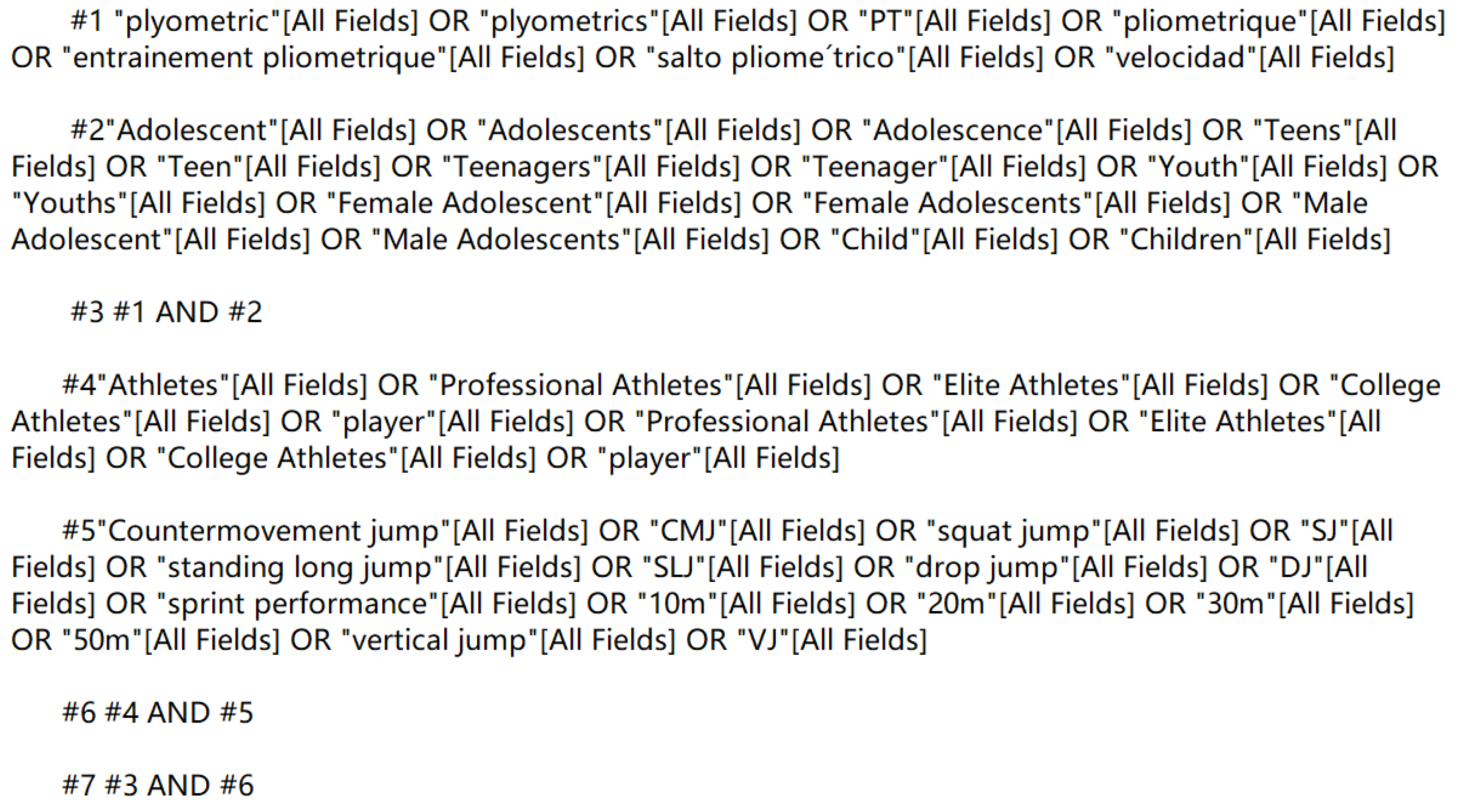
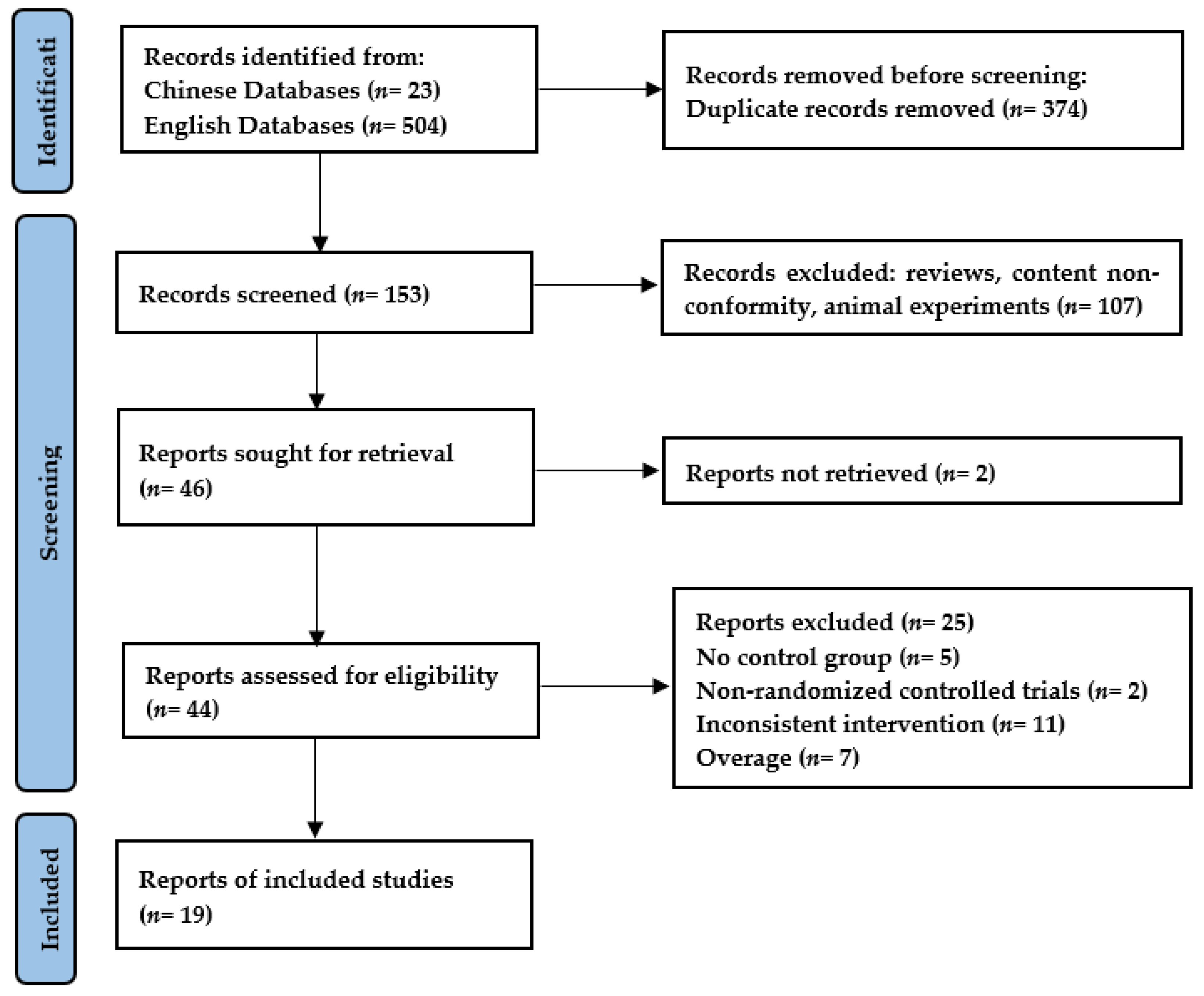
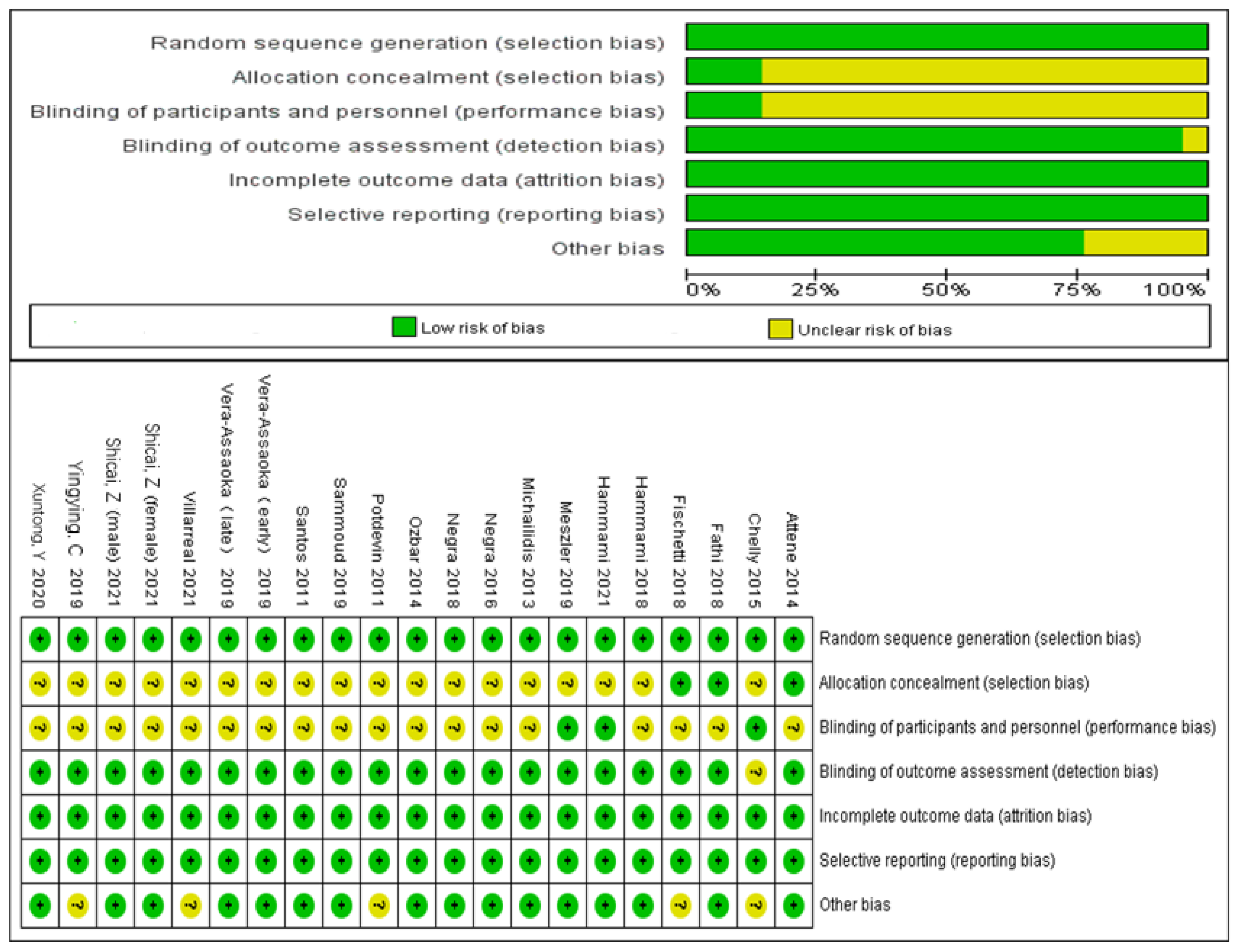
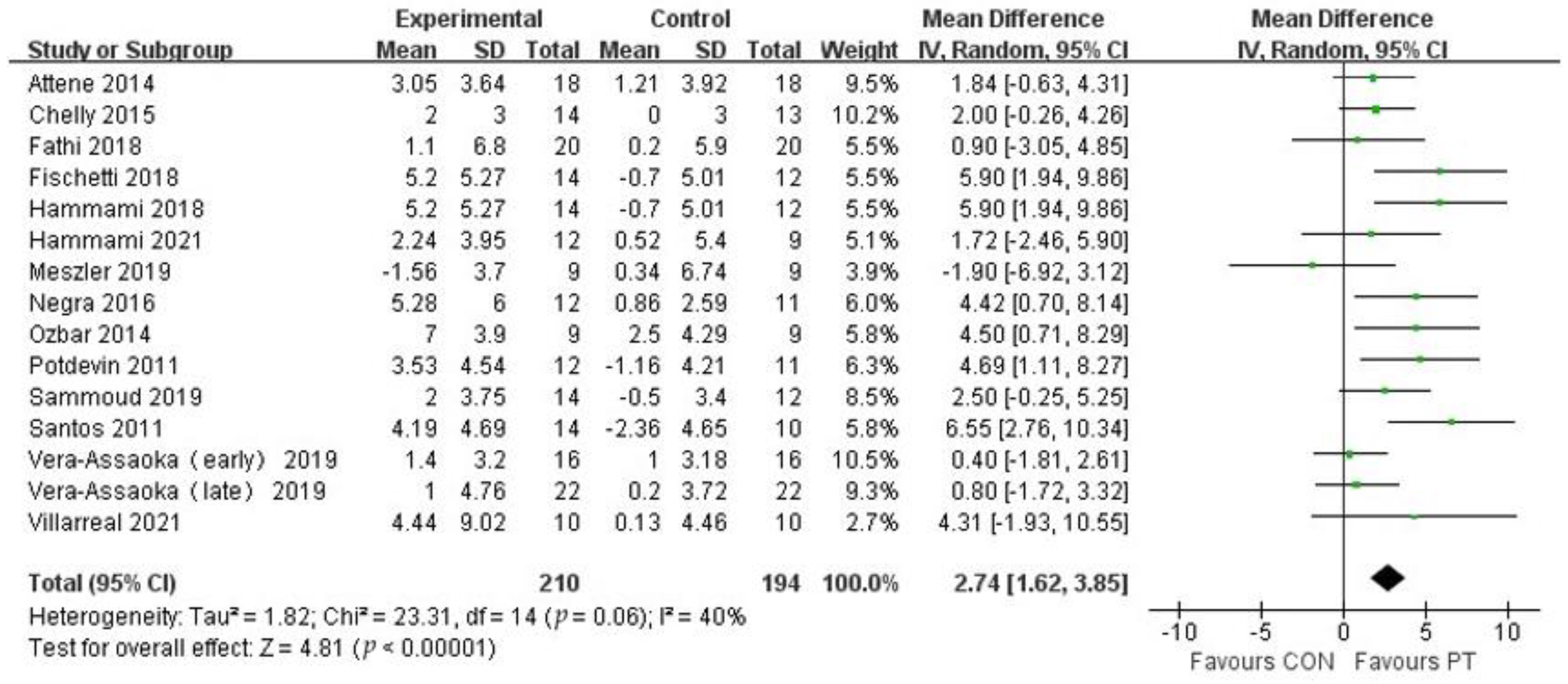
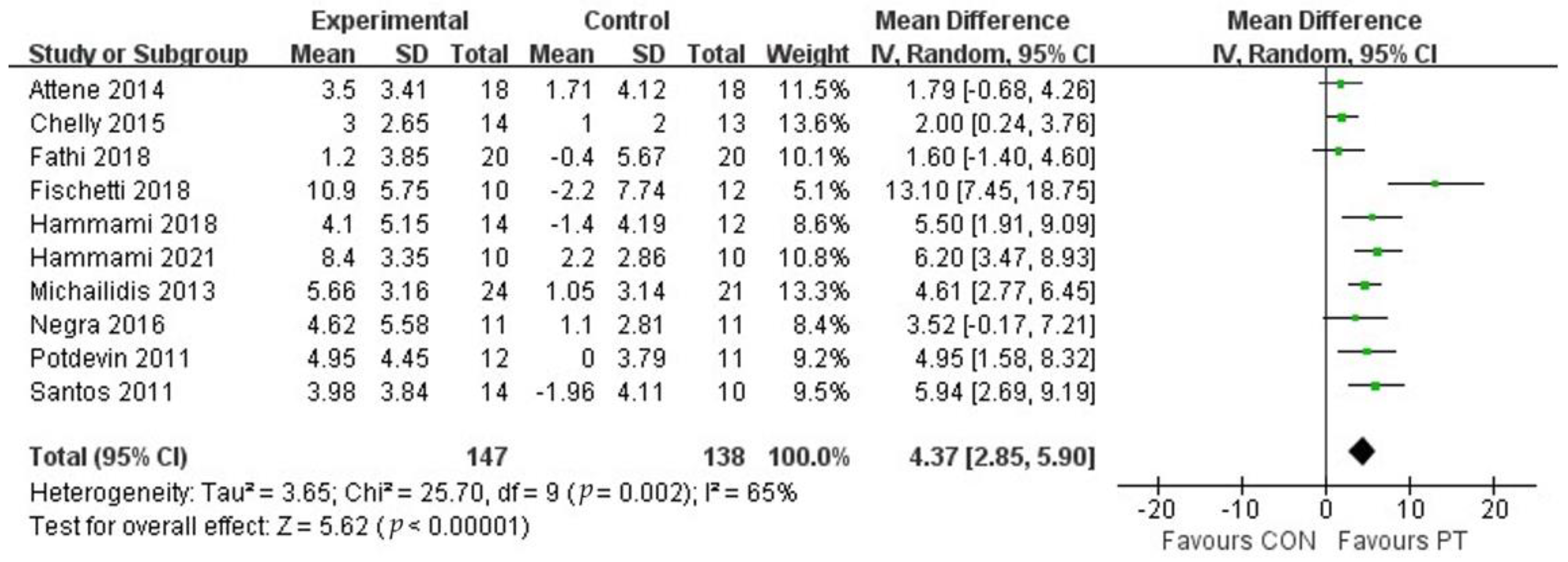



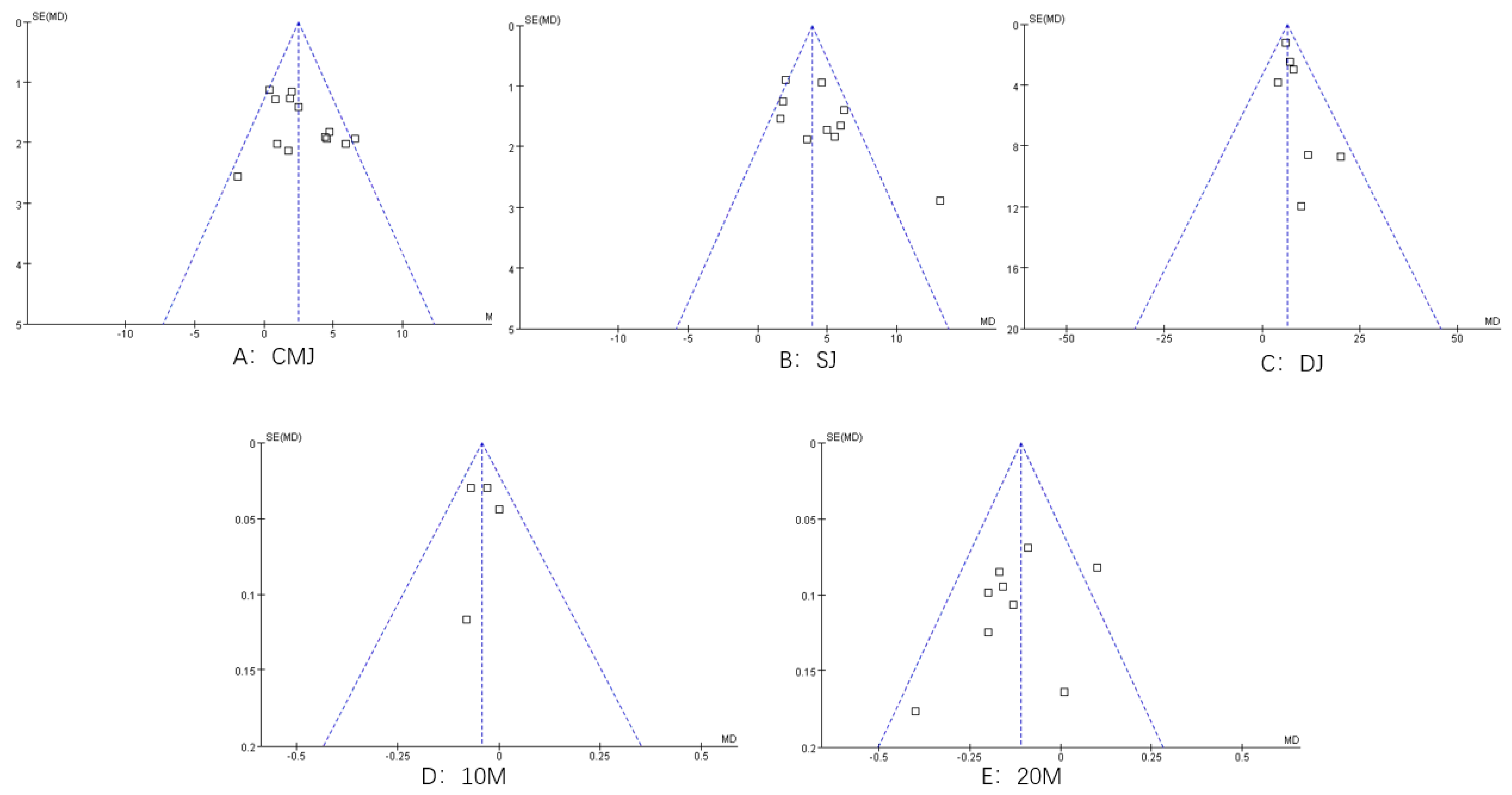
| Studies | Genders | Sample Size | Age | Experimental Group | Control Group | Key Outcome Indicators | |||||
|---|---|---|---|---|---|---|---|---|---|---|---|
| PT | CON | PT | CON | Interventions | PT Duration | Frequency | Duration | Interventions | |||
| Attene [30] 2014 | Female | 18 | 18 | 14.9 ± 0.9 | 14.4 ± 0.7 | Basketball + PT | 20 min | 2/week | 6 weeks | Basketball | CMJ, SJ |
| Chelly [31] 2015 | Male | 14 | 13 | 11.9 ± 1.0 | 11.9 ± 1.0 | Sprint + PT | 20 min | 4/week | 10 weeks | sprint | CMJ, SJ |
| Fathi [32] 2018 | Male | 20 | 20 | 14.6 ± 0.5 | 14.5 ± 0.6 | Volleyball + PT | 25 min | 2/week | 16 weeks | Volleyball | CMJ, SJ, 10 m |
| Fischetti [33] 2018 | Male | 10 | 12 | 13.7 ± 0.5 | 13.5 ± 0.5 | Track and Field + PT | 15 min | 2/week | 8 weeks | Track and Field | CMJ, SJ, 20 m |
| Hammami [34] 2018 | Male | 14 | 12 | 15.7 ± 0.2 | 15.8 ± 0.2 | Football + PT | 25–30 min | 2/week | 8 weeks | Football | CMJ, SJ |
| Hammami [35] 2021 | Male | 10 | 10 | 16.4 ± 0.5 | 16.5 ± 0.4 | Handball + PT | 25–30 min | 2/week | 7 weeks | Handball | CMJ, SJ, 10 m, 20 m |
| Meszler [36] 2019 | Female | 9 | 9 | 15.8 ± 1.2 | 15.7 ± 1.3 | Basketball + PT | 20 min | 2/week | 7 weeks | Basketball | CMJ |
| Michailidis [37] 2013 | Male | 24 | 22 | 10.7 ± 0.7 | 10.6 ± 0.5 | Football + PT | 20–25 min | 2/week | 12 weeks | Football | SJ, 10 m, 20 m |
| Negra [38] 2016 | Male | 11 | 11 | 12.7 ± 0.3 | 12.8 ± 0.3 | Football + PT | 35–40 min | 2/week | 12 weeks | Football | CMJ, SJ, SLJ, 20 m |
| Negra [39] 2018 | Male | 13 | 11 | 12.7 ± 0.2 | 12.7 ± 0.2 | Football + PT | 25–35 min | Bi-weekly | 8 weeks | Football | 20 m |
| Ozbar [40] 2014 | Female | 9 | 9 | 18.3 ± 2.6 | 18.0 ± 2.0 | Football + PT | 60 min | Bi-weekly | 8 weeks | Football | CMJ, SLJ, 20 m |
| Potdevin [41] 2011 | Male/Female | 12 | 11 | 14.3 ± 0.2 | 14.1 ± 0.2 | Swim + PT | 10 min | 2/week | 6 weeks | Swim | CMJ, SJ |
| Sammoud [42] 2019 | Male | 14 | 12 | 10.3 ± 0.4 | 10.5 ± 0.4 | Swim + PT | 20–35 min | 2/week | 8 weeks | Swim | CMJ, SLJ |
| Santos [43] 2011 | Male | 14 | 10 | 15.0 ± 0.5 | 14.5 ± 0.4 | Basketball + PT | 20 min | 2/week | 10 weeks | Basketball | CMJ, SJ |
| Vera-Assaoka [44] (early) 2019 | Male | 16 | 16 | 11.2 ± 0.8 | 11.5 ± 0.9 | Football + PT | 21 min | 2/week | 7 weeks | Football | CMJ, 20 m |
| Vera-Assaoka [44] (late) 2019 | Male | 22 | 22 | 14.4 ± 1.0 | 14.5 ± 1.1 | Football + PT | 21 min | 2/week | 7 weeks | Football | CMJ, 20 m |
| Villarreal [45] 2021 | Male | 10 | 10 | 13.57 ± 1.39 | 14.66 ± 0.86 | Basketball + PT | 20 min | 2/week | 7 weeks | Basketball | CMJ, 10 m, 20 m |
| Zhou [46](M) 2021 | Male | 8 | 8 | 10.01 ± 1.06 | 10.75 ± 1.03 | Badminton + PT | 20–30 min | 3/week | 8 weeks | Badminton | SLJ |
| Zhou [46](W) 2021 | Female | 8 | 8 | 10.01 ± 1.06 | 10.75 ± 1.03 | Badminton + PT | 20–30 min | 3/week | 8 weeks | Badminton | SLJ |
| Cheng [47] 2019 | Male | 10 | 10 | 16.5 ± 0.5 | 16.60 ± 0.52 | Sprint + PT | 90 min | 3/week | 12 weeks | sprint | SLJ |
| Yan [48] 2020 | Male/Female | 8 | 8 | 14.6 ± 0.7 | 14.6 ± 0.7 | Badminton + PT | 60 min | 2/week | 12 weeks | Badminton | SLJ |
Disclaimer/Publisher’s Note: The statements, opinions and data contained in all publications are solely those of the individual author(s) and contributor(s) and not of MDPI and/or the editor(s). MDPI and/or the editor(s) disclaim responsibility for any injury to people or property resulting from any ideas, methods, instructions or products referred to in the content. |
© 2023 by the authors. Licensee MDPI, Basel, Switzerland. This article is an open access article distributed under the terms and conditions of the Creative Commons Attribution (CC BY) license (https://creativecommons.org/licenses/by/4.0/).
Share and Cite
Chen, L.; Zhang, Z.; Huang, Z.; Yang, Q.; Gao, C.; Ji, H.; Sun, J.; Li, D. Meta-Analysis of the Effects of Plyometric Training on Lower Limb Explosive Strength in Adolescent Athletes. Int. J. Environ. Res. Public Health 2023, 20, 1849. https://doi.org/10.3390/ijerph20031849
Chen L, Zhang Z, Huang Z, Yang Q, Gao C, Ji H, Sun J, Li D. Meta-Analysis of the Effects of Plyometric Training on Lower Limb Explosive Strength in Adolescent Athletes. International Journal of Environmental Research and Public Health. 2023; 20(3):1849. https://doi.org/10.3390/ijerph20031849
Chicago/Turabian StyleChen, Lunxin, Zhiyong Zhang, Zijing Huang, Qun Yang, Chong Gao, Hongshen Ji, Jian Sun, and Duanying Li. 2023. "Meta-Analysis of the Effects of Plyometric Training on Lower Limb Explosive Strength in Adolescent Athletes" International Journal of Environmental Research and Public Health 20, no. 3: 1849. https://doi.org/10.3390/ijerph20031849
APA StyleChen, L., Zhang, Z., Huang, Z., Yang, Q., Gao, C., Ji, H., Sun, J., & Li, D. (2023). Meta-Analysis of the Effects of Plyometric Training on Lower Limb Explosive Strength in Adolescent Athletes. International Journal of Environmental Research and Public Health, 20(3), 1849. https://doi.org/10.3390/ijerph20031849






